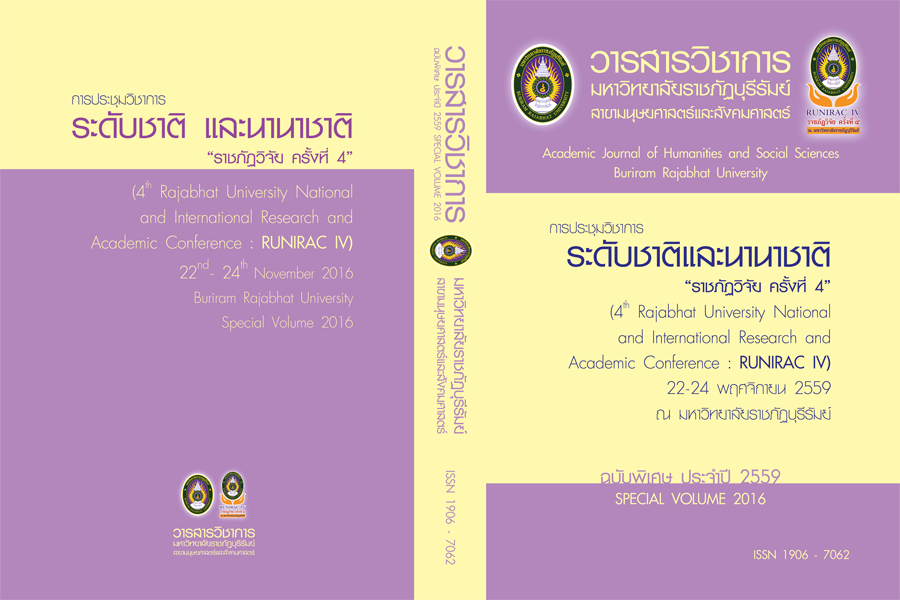Perceiving and Enacting Language and Culture from Film in a Tertiary English Classroom in Vietnam
Main Article Content
บทคัดย่อ
วิจัยนี้มีวัตถุประสงค์เพื่อนำ เสนอแนวทางในการสอนการเรียนรู้ภาษาทางวัฒนธรรมจาก
ภาพยนตร์ในชั้นเรียน ซึ่งนำ เสนอเกี่ยวกับชั้นเรียนทดลองที่ครูได้แนะให้นักเรียนรู้จักลักษณะทางสังคม
และวัฒนธรรมในฉากภาพยนตร์ประสบการณ์ทำ ให้นักศึกษามีส่วนร่วมในการค้นหาความเข้าใจและ
การทดลองทางกายภาพขององค์ประกอบต่างๆเหล่านี้โดยครูเป็นแรงส่งเสริมให้นักศึกษาเกิดความ
เข้าใจและการใช้พฤติกรรมที่สื่อด้วยคำ พูดและที่ไม่ใช้คำ พูดการตอบรับของนักเรียนที่เข้าร่วมแสดงให้
เห็นถึงการรับรู้ประโยชน์และความท้าทายที่พบในวิธีการแบบบูรณาการการเรียนรู้ภาษาทางวัฒนธรรม
จากภาพยนตร์ประสบการณ์เหล่านั้นก่อให้เกิดวิธีการที่มีประสิทธิภาพซึ่งนำ ไปสู่การปฏิบัติและทัศนคติ
ของคนในสังคมภาษาเป้าหมาย
Article Details
ประเภทบทความ
บทความวิจัย (Research Paper)
- ต้นฉบับที่ได้รับการตีพิมพ์ในวารสารวิชาการ มหาวิทยาลัยราชภัฏบุรีรัมย์ สาขามนุษยศาสตร์และสังคมศาสตร์ ถือเป็นกรรมสิทธิ์ของมหาวิทยาลัยราชภัฏบุรีรัมย์ ห้ามนำข้อความทั้งหมดหรือบางส่วนไปพิมพ์ซ้ำเว้นเสียแต่ว่าจะได้รับอนุญาตจากมหาวิทยาลัยฯ เป็นลายลักษณ์อักษร
- เนื้อหาต้นฉบับที่ปรากฏในวารสารเป็นความรับผิดชอบของผู้เขียน ทั้งนี้ไม่รวมความผิดพลาด อันเกิดจากเทคนิคการพิมพ์
เอกสารอ้างอิง
Crozet, C., & Liddicoat, A. (1999). The challenge of intercultural language teaching:
Engaging with culture in the classroom. In J. Lo Bianco et al. (Eds.), Striving
for the third place: Intercultural competence through language education
(pp.113-125). Melbourne: Language Australia.
Crozet, C., & Liddicoat, A. (1999). The challenge of intercultural language teaching:
Engaging with culture in the classroom. In J. LoBiancoet al. (Eds.), Striving for
thethird place: Interculturalcompetencethroughlanguageeducation(pp.113-
125). Melbourne: Language Australia.
Halliday, M. A. K. (1978). Language as social semiotic: The social interpretation
of language and meaning. Baltimore: University Park Press.
Halliday, M. A. K. (1991). Thenotionof “context” inlanguage education. InT. Le & M.
McCausland (Eds.), Language and education: Interaction and development.
Proceedings of the International Conference, Ho Chi Minh City, Vietnam,
30 March-1 April, 1991 (pp.1-26). Amsterdam: John Benjamin.
Ho, ST K. (2009). Addressing Culture in EFL Classrooms: The Challenge of Shifting
from a Traditional to an Intercultural Stance. Electronic Journal of Foreign
Language Teaching, Vol. 6, No. 1, pp. 63–76.
Kaiser, M. (2011). IntroductiontotheSpecial Issue. L2 Journal,Volume3, pp. 141-143.
Kramsch, C. (1993). Context and cultureinlanguageteaching. Oxford: Oxford
University Press.
Kramsch, C. (1998). Language and culture. Oxford: Oxford University Press.
Liddicoat, A. (2005). Teaching languages for intercultural communication. In D.
Cunningham & A. Hatoss (Eds.), An international perspective on language
policies, practices and proficiencies: Festschrift for David E. Ingram
(pp. 201-214). Belgrave, Vic: Federation Internationale des Professeurs
de Langues Vivantes.
Liddicoat, A. & Scarino, A. (2013). Intercultural languageteaching and learning. Oxford:
Wiley-Blackwell.
Nguyen, H C. (2002). Doi thoaivanhoavavan de day-hocngoaingu. (Cultural dialogue
and foreignlanguageinstruction).Proceedingsof theInternationalconference
on foreign language education- Integration and Development, Ha Noi,
Vietnam, November15,2002(pp.127-130). Hanoi National University College
of Foreign Languages.
Orton, J. (2002). Corecultureinlanguagelearning. ForeignLanguageTeaching Abroad,
6 (4), 48-55.
Pegrum, M. (2008). Film, culture and identity: Critical intercultural literacies for the
language classroom. Language and Intercultural communication, 8(2),
136-154.
Scollon, R., & Scollon, S. (2001). Intercultural communication: A discourse approach.
Malden, Mass.: Blackwell Publishers.
Sherman, J. (2003). Using authentic video in the language classroom. Cambridge:
Cambridge University Press.
Turner, G. (2006). Film as social practice. London: Routledge.
Engaging with culture in the classroom. In J. Lo Bianco et al. (Eds.), Striving
for the third place: Intercultural competence through language education
(pp.113-125). Melbourne: Language Australia.
Crozet, C., & Liddicoat, A. (1999). The challenge of intercultural language teaching:
Engaging with culture in the classroom. In J. LoBiancoet al. (Eds.), Striving for
thethird place: Interculturalcompetencethroughlanguageeducation(pp.113-
125). Melbourne: Language Australia.
Halliday, M. A. K. (1978). Language as social semiotic: The social interpretation
of language and meaning. Baltimore: University Park Press.
Halliday, M. A. K. (1991). Thenotionof “context” inlanguage education. InT. Le & M.
McCausland (Eds.), Language and education: Interaction and development.
Proceedings of the International Conference, Ho Chi Minh City, Vietnam,
30 March-1 April, 1991 (pp.1-26). Amsterdam: John Benjamin.
Ho, ST K. (2009). Addressing Culture in EFL Classrooms: The Challenge of Shifting
from a Traditional to an Intercultural Stance. Electronic Journal of Foreign
Language Teaching, Vol. 6, No. 1, pp. 63–76.
Kaiser, M. (2011). IntroductiontotheSpecial Issue. L2 Journal,Volume3, pp. 141-143.
Kramsch, C. (1993). Context and cultureinlanguageteaching. Oxford: Oxford
University Press.
Kramsch, C. (1998). Language and culture. Oxford: Oxford University Press.
Liddicoat, A. (2005). Teaching languages for intercultural communication. In D.
Cunningham & A. Hatoss (Eds.), An international perspective on language
policies, practices and proficiencies: Festschrift for David E. Ingram
(pp. 201-214). Belgrave, Vic: Federation Internationale des Professeurs
de Langues Vivantes.
Liddicoat, A. & Scarino, A. (2013). Intercultural languageteaching and learning. Oxford:
Wiley-Blackwell.
Nguyen, H C. (2002). Doi thoaivanhoavavan de day-hocngoaingu. (Cultural dialogue
and foreignlanguageinstruction).Proceedingsof theInternationalconference
on foreign language education- Integration and Development, Ha Noi,
Vietnam, November15,2002(pp.127-130). Hanoi National University College
of Foreign Languages.
Orton, J. (2002). Corecultureinlanguagelearning. ForeignLanguageTeaching Abroad,
6 (4), 48-55.
Pegrum, M. (2008). Film, culture and identity: Critical intercultural literacies for the
language classroom. Language and Intercultural communication, 8(2),
136-154.
Scollon, R., & Scollon, S. (2001). Intercultural communication: A discourse approach.
Malden, Mass.: Blackwell Publishers.
Sherman, J. (2003). Using authentic video in the language classroom. Cambridge:
Cambridge University Press.
Turner, G. (2006). Film as social practice. London: Routledge.


